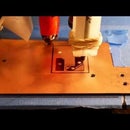Introduction: Using Battery Configurator
Battery Configurator, available at https://battery.market/battery-configurator/ is a tool to help you configure your lithium-ion battery build. It calculates things like if you have enough cells in parallel to handle your expected load, and gives you guideline parameters to charge and discharge your battery safely.
Battery Configurator is a work in progress, and so this article is as of August 2021. The tool may have seen improvements since
Step 1: Selecting the Chemistry Type
I don't know why this option is last in the tool, but my preference is to start with the battery chemistry to make sure I get the right parameters everywhere else. You have 3 choices, and they will change the recommended charge and discharge voltage cutoffs.
Step 2: Series
Now that you have the right chemistry, you can select the number of cells in series. The reason I liked having the chemistry first, is if you have a target voltage instead of a target series configuration, you can see and adjust the number of cells you will have in series.
Step 3: Parallel Cells
Now you enter how many cells you intend on putting in parallel. You may have to adjust this at the end, but we first need a figure as a starting point. If you really don't know, you can leave it to the default value and change it at the end.
Step 4: C Rating and Capacity
I put these two together because together, they give you the cell output. However, if you don't have the C rating, but you have the cell max output, you can get the C rating by doing max A / capacity in Ah. If you entered the capacity in mah, you can just click to convert it to Ah.
Step 5: Cell Size
By entering the cell diameter, and whether there is a cell holder or not, you can get an estimate of the amount of nickel strips (or copper or steel) that you will need at the end. This only works for circular cells.
Step 6: Busbar Material
Now select your busbar material (usually you want pure nickel, but some will use nickel plated steel or copper / nickel plated copper). Nickel plated copper is not available, but pure copper is a good proxy because the nickel plating is to prevent oxidation, not for conductance, most of the conductance comes from the copper inside the plating anyways.
Once you have that, select the appropriate material width and thickness.
Step 7: Expected Current Draw
Now, you finally enter how much current you think you will be drawing in Amps. This will be the last figure needed to compute if you have enough cells in parallel, and how much busbar material you will need to continuously handle that current.
Step 8: Check That You Have the Right Number of Cells in Parallel
Check that you have at least the minimum number of cells in parallel. This is based on the max current the cells can safely output (C rating from earlier), and the amount of current you want to draw. If the number is bigger than your P value from earlier, then you will have to increase the size of you battery.
Step 9: Number of Cells
Now that your series and parallel configurations are correct, you can know how many cells you will need.
Step 10: Busbar Material Needs
Now the tool gives you how many layers of your chosen busbar material will be needed to handle the current you want to push through your battery. This is for the series connections only, the parallel connection between cells can remain at a single layer. This is reflected in the calculator's output of the number of strips you need. At this time, the calculator assumes a few things.
1- you are using single strips, not parallel type strips.
2- you are building this as a rectangle
The nice thing is it also gives you a total length so you know how much your project will need.











